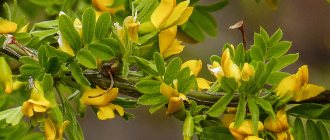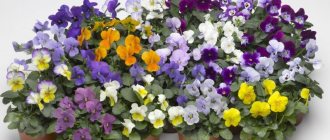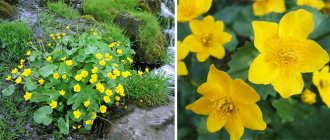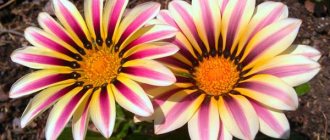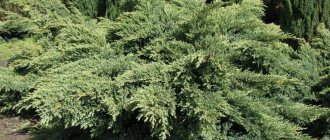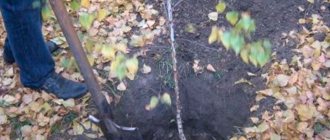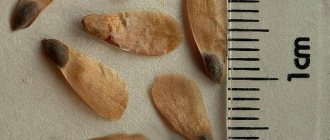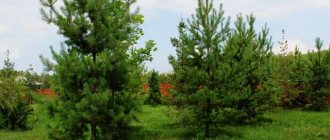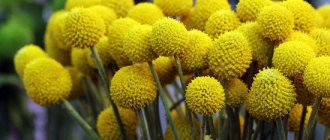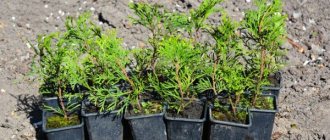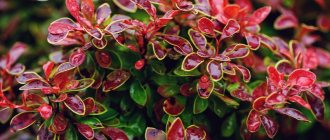Thuja occidentalis Brabant is a common unpretentious conifer. This culture comes from North America, so it easily took root in Russia, namely in the central and northern regions. In the southern regions it practically does not occur, since the plant does not tolerate heat and dry air. This type of conifer looks good in single and group plantings with other garden crops, and it can also be used as a “living” hedge.
Thuja Brabant does not change the shade of its needles
Reason for popularity
The demand for Thuja Brabant is explained by its ease of care and high decorative qualities throughout the year. This conifer easily tolerates transplantation and quickly adapts to new conditions.
The plant is undemanding to the composition and acidity of the soil, so it can be planted in areas where other garden crops do not take root. Thuja Brabant does not suffer from air pollution, so it can be used for landscaping areas in urban areas.
The high popularity of the plant is also explained by the fact that this conifer is easy to shape and quickly recovers after pruning. The crop is easily propagated by cuttings, which allows you to obtain a large number of young seedlings.
Which variety do you prefer: Brabant or Smaragd?
These are the two most popular varieties that gardeners prefer for decorating a site or creating a hedge. What are their features?
| Brabant variety | Variety Smaragd |
| The choice for those who want to see the creation of their own hands: a hedge made of thuja in a short time. Its growth rate is half a meter per year. To create a dense and fluffy crown, it is necessary to cut the crop 2 times per season. And to obtain an impenetrable green hedge, planting should be done every meter. | It also has a conical crown and light green needles. The crown is narrow-pyramidal, maintaining a green color throughout the year. The crown is lush and does not require frequent pruning, because grows slowly. To ensure a dense green wall, plants should be planted 80 cm apart. |
| The needles are light green. The shape of the bush can be modified. Characterized by rapid growth. Most often used to create hedges. | The color of the needles is more saturated. The crown “holds” its shape well. More decorative. |
| It is photophilous and tolerates waterlogging, but cannot withstand severe frosts. | Shade-tolerant, can withstand frost of -40C, but the soil needs to be drained. |
Both varieties, despite certain differences, tolerate cutting and shaping well. Compositions or geometric classics: the choice is yours.
How does Thuja Brabant grow?
This conifer belongs to the Cypress family. And just like its other representatives, it is a long-liver. Thuja Brabant can grow in one place for 150 years. The plant is highly frost-resistant and does not suffer from temperatures dropping to -30 degrees.
The plant is a light-loving plant, but does not tolerate direct sunlight throughout the day, as this causes dehydration of the needles. Therefore, it is recommended to plant Thuja Brabant in slightly shaded areas.
Important! With a lack of light, the crown becomes loose, which negatively affects the decorative effect of the plant.
Brabant is an unpretentious variety of Western thuja, so it can be grown in any type of soil. At the same time, the plant easily tolerates short-term drying out and waterlogging of the soil. But maximum decorativeness can be achieved by planting the plant on breathable, fertile soils.
Features of traditional and special plant care procedures
Maintaining comfortable conditions for the development and growth of western thuja involves carrying out traditional and special measures to care for plantings. In the first month after planting the plant in open ground, the tree trunk circle is moistened once a week. In dry weather - 2 times. Loosening of the soil is carried out monthly, to a depth of 10–12 centimeters - no more, since the thuja drummer root system is located close to the surface of the earth and is easily damaged.
The plant responds very positively to sprinkling, especially during dry periods. The event should be scheduled early in the morning or in the evening after sunset. Pruning begins from the third year of the thuja's life - in June and at the end of August. The upper part is trimmed to the desired height, all damaged and dried areas are cut off. Regular trimming leads to the crown becoming denser and thicker each time.
It is important to take into account one feature: thuja shoots are cut to no more than a third of their length, so as not to have a negative impact on the health of the plant.
To trim the crown of a thuja, you need to use only a well-sharpened pruner, which will not injure the cut areas, making them as even as possible.
When preparing thuja plantings for winter, so that the branches of the plants do not break, they are tied with twine or rope. Young bushes should additionally be covered with spruce branches to protect the delicate needles from the scorching rays of the sun in the spring, and the roots from freezing of the soil.
Western thujas are fed in the spring season by applying complex fertilizers, for example, Kemira-Universal - 50 grams per 1 square meter of planting area.
Description and characteristics of thuja Brabant
When choosing a given ephedra, it is necessary to study its main characteristics. This information will allow you to correctly place it on the site, as well as combine it with other garden crops.
Height of an adult Thuja Brabant plant
An adult conifer under natural conditions can reach a height of 20 m. In the middle zone it usually does not exceed 5 m.
Thuja Brabant width
The crown width of an adult thuja Brabant is about 4 m over the age of 30 years. Therefore, when planting, these parameters should be taken into account, since if there is a lack of free space, the decorative value of the needles is reduced.
Crown diameter of Thuja Brabant
Ephedra is distinguished by a lush conical crown. At the same time, it is compact and often the branches of the tree reach the ground. The diameter of the crown in the lower tiers reaches 4 m, and closer to the top it narrows noticeably.
Thuja Brabant growth rate
Ephedra belongs to the fast-growing category. The annual increase in height is 30 cm, and in width - 10 cm. Thanks to this feature, you can get a hedge of Thuja Brabant in the shortest possible time.
This type of crop responds well to sprinkling
Thuja Brabant root system
Ephedra has a branched root system. It is located horizontally in relation to the soil surface and does not go into deep layers. The radius of growth of the root system is about 1.5 m. Therefore, when planting near a fence, it is necessary to make an indent of at least 1.0 m.
Important! Thuja Brabant should not be planted directly next to the asphalt surface, since during the growth process the lateral roots will easily lift it up.
Description of the variety
Thuja occidentalis Brabant, being an already mature tree growing in natural conditions, can reach 20 meters. On the site, the average height of an adult plant rarely exceeds four meters. It grows very quickly - the incremental growth per year is about 30 cm.
Thuja Brabant can tolerate frosts down to -35 °C, so it can be grown in many regions of Russia. The green, thick, scaly needles retain their color all year round. The bark of the thuja is gray with a red or brown tint. The shape of the tree crown is cone-shaped.
Thuja Brabant blooms from mid-spring to early summer. Then, cone fruits appear on the tree, the size of which is from 5 to 12 mm. They are brown in color and oval in shape. Thuja prefers sunny places. It can grow in shaded areas, but it develops worse, the needles acquire a dull shade, and the crown loses its decorative effect.
Thuja Golden Brabant is a variety of Thuja occidentalis Brabant. It has golden-yellow needles, which become even brighter when grown in sunny places. Retains the color of the needles all year round.
Which thuja is better Columna or Brabant
Both conifers grow well in any soil and do not change color throughout the year. But unlike Brabant, Columna is characterized by slow growth and annually adds no more than 15 cm in height. This type also differs in appearance.
Thuja Columna is a tree with an upright trunk, from which branches extend at right angles. The width of an adult plant does not exceed 1.5 m, so growing a “hedge” from this conifer is much more difficult, since you will have to place the seedlings very close to each other. But unlike Brabant, Columna does not require crown formation. Trimming can only be used to adjust height.
Important! According to landscape designers, Kolomna thuja is best used for landscaping parks and squares, and Brabant is best used for garden plots.
Caring for Thuja Brabant
This plant is considered an unpretentious variety to care for, but, nevertheless, it has some preferences for soil, humidity level, amount of light, temperature conditions, etc. If you do not take into account the basic rules for growing thuja, the decorative functions may be lost or the plant will dry out. The basic rule is systematic pruning of shoots to give a beautiful shape.
The soil
After planting, immediately water the seedling with plenty of water - the tree prefers moist soil. Then you need to mulch the near-trunk area of each tree with a layer of 10-12 cm. Mulch helps retain moisture in the ground, prevents weeds from overheating and growing, and nourishes the roots with useful substances. In winter, it protects the root from the cold and prevents the soil from turning to stone. Peat, bark, and compost can be used as mulch.
Watering
In the first weeks after planting, thuja Brabant should be watered abundantly every day, because from a lack of water, young shoots wither, turn yellow and crumble, and the crown thins out, and all decorative and aesthetic functions are lost. The roots should always be moderately moistened - not too dry or wet. The plant needs constant loosening at a depth of 12-15 cm.
Top dressing
Fertilizers for this variety of thuja are not much different from feeding for other species. If the thuja is planted in the spring-summer season, then in the fall it is necessary to fertilize it with potassium-phosphorus fertilizer. The following year, the subcortex is carried out in the spring, with dry water-soluble fertilizer “Kemira Lux”. After 2 weeks, watering is repeated. In the fall, mixtures containing potassium and phosphorus will be needed again.
Crown formation
To keep the tree beautiful and with a dense crown, it must be constantly trimmed. Trimming should be done in spring and late summer, when the growth of new shoots stops. Pruning is done in cloudy weather to protect the tree from burns. The haircut should be such that the composition at the top is narrower than at the bottom - a conical crown. It is not recommended to cut shoots down to old wood.
Which is better thuja Smaragd or Brabant
In terms of popularity, these two types of western thuja are not inferior to each other. Both of them have high decorative qualities and combine well with other garden crops. But, despite the fact that Smaragd is not characterized by rapid growth and its annual increase in height is 10 cm, and in width only 5 cm, it has become more widespread. This is due to increased resistance to adverse climatic conditions. Smaragd does not suffer from frosts down to -40 degrees.
The difference between Thuja Smaragd and Brabant lies in the density of the crown. The first type has a more lush, rich green color, while the second has a lighter shade. Otherwise they are very similar. Having compared both types, we can say that Brabant should be chosen if you need to get a hedge or composition as quickly as possible, and Smaragd - when grown in single plantings and to obtain thick, lush conifers.
Benefits of Thuja Brabant for hedges
Growing a green hedge from thuja has become a popular activity today. And this is explained simply: the plant is durable and undemanding. From the crown you can create all kinds of shapes (arches, balls, etc.) that will delight you all year long. In addition, thuja tolerates pruning well and retains its shape for a long time. The main purpose of the fence is to protect the site from uninvited guests and inquisitive eyes. The thuja tree copes well with this: it grows up to 12–20 m.
Among other important functions of thuja they note:
- retention of snow mass;
- air saturation with ions;
- creating a relaxing atmosphere;
- protection from debris and wind.
It is very good to grow the Brabant variety (Thuja occidentalis Brabant) as a living defense. It grows quickly, up to 40–50 cm per year, and reaches a height of 8–15 m. The crown volume is 2–3 m. Planted Brabant grows in width, forming a dense plant canopy. Thanks to this ability, the plant is not used to create a simple hedge, but is decorated with various shapes.
Proper planting and care
In order for Thuja Brabant to fully develop and quickly adapt to a new place, it is necessary to plant it correctly. In this case, it is important to decide in advance on a permanent location, since any transplant significantly slows down the growth of the conifer.
Conifers need to be planted so that there is enough space for other plants in the composition
At what distance to plant thuja Brabant
When planting conifers in a row, it is necessary to take into account the diameter of the mature tree. Therefore, seedlings need to be planted at a distance of 0.8 m. This will allow them to fully develop and not compete with each other for light, space and nutrients. This distance will ultimately allow you to get a dense hedge-wall of Thuja Brabant.
In the case of a single planting of ephedra or its combination in a composition with other garden crops, it is recommended to maintain a distance of at least 1.0 m.
How to plant thuja Brabant for a hedge
It is recommended to plant thuja Brabant in autumn or spring at a temperature of at least +10 degrees. Before carrying out the procedure, you need to prepare the area in advance, dig it up with a shovel and carefully remove all the roots of perennial weeds. It is important that the seedlings are planted at the same level, so it is recommended to drive pegs along the edges of the row and pull the twine. This will allow you to place the Brabant thuja strictly along the line.
2 weeks in advance, you should prepare planting holes measuring 70 by 90 cm and fill them with a nutrient mixture. Each should consist of the following components:
- 2 parts of turf;
- 1 part sand;
- 1 part humus;
- 1 part peat.
Additionally add 30 g of superphosphate and 20 g of potassium sulfide. Nitrogen fertilizers cannot be applied during planting.
Procedure:
- Water the planting hole generously.
- Remove the seedling from the pot, inspect the roots, cut off any shoots that stand out from the general mass.
- Place the thuja in the center without deepening the root collar.
- Fill the voids with soil, shaking the seedling occasionally.
- Compact the surface at the base and water again.
- Repeat the procedure for each plant in the row.
Important! When planting a hedge, it is necessary that all seedlings have equally strong root systems, the same age and height, otherwise weak specimens will eventually be drowned out by stronger ones.
Watering and fertilizing
Thuja Brabant needs regular watering in the first months after planting. In order for the plant to quickly take root in a new place, it is necessary to constantly keep the soil slightly moist. On hot days, watering is carried out daily using settled water. And in other periods 2 times a week in the absence of precipitation.
Feeding should begin when the seedling is three years old. Apply fertilizers three times per season. The first time is in early spring, using nitrogen mineral mixtures. The second is during the active growing season using organic matter. And the third - in the fall. During this period, the conifer needs phosphorus-potassium fertilizer, which will strengthen its immunity before wintering.
Seedlings need to be watered at the rate of 10 liters per plant
How to prune thuja Brabant
Thuja Brabant should be pruned at the age of 3 years. By this time, the plant has gained enough green mass and therefore needs to be given a presentable appearance. For this you can use a coarse mesh. It must be pulled evenly over the crown and all protruding shoots must be cut off. You should also additionally remove all dried and damaged branches. When the thuja Brabant reaches the required height, you also need to cut off the top. Trimming the thuja Brabant allows you to make the plant lush.
The procedure should be carried out in early June and in the first half of September.
Planting and care - preparing the site and creating favorable conditions for the development of thuja
In order to plant thuja, it is recommended to choose sunny areas of the garden or local area, because the shade negatively affects the color saturation of the needles and slows down the growth of the plant as a whole. As for the soil, light loamy or peaty is preferable. When planting in heavy soil, it is necessary to create an additional drainage layer at the bottom of the planting hole, at least 15 centimeters thick.
The planting hole itself is dug in accordance with the size of the earthen ball in which the rhizome of the seedling is located. Depth from 75 to 90 centimeters depending on the age of the plant and soil characteristics. It is advisable to prepare the soil with which the volume of the pit will be filled in advance so that it has time to be saturated with the nutrients added to it. A mixture of peat, turf soil and sand in a ratio of 1:2:1 is best. To stimulate growth, it is recommended to add nitroammophosphate - up to 100 grams per thuja.
Western thuja can be planted from spring to autumn, however, the most suitable months are April and May. Plants planted during this period are less susceptible to diseases and parasite attacks, take root faster in a new place and successfully acclimatize. Planting in the autumn season carries the risk that the thuja will not have time to take root firmly in the soil before the onset of winter cold and will die.
The main criterion for the success of growing western thuja is the health and quality of the seedling. When purchasing, you should definitely pay attention to the elasticity of the needles and the richness of its varietal color. There should be no yellowing or dried areas on the branches. There should be no signs of fungal diseases or insect pests. Thuja needles are especially loved by aphids and spider mites.
Description of planting thuja in open ground:
- The bottom of the pit is filled in layers: first, drainage from broken bricks or expanded clay, then a layer of soil prepared to fill the volume of the pit.
- Preparing a seedling involves spraying an earthen ball with clean water at room temperature or a solution of a drug to stimulate root formation - Kornevin or Epin.
- The thuja is placed in a hole so that the root collar of the plant is flush with the surface of the earth, and then covered with soil.
- During the process of filling the hole, the soil mixture is compacted by hand to avoid the formation of air voids, which in the future can lead to rotting of the root shoots of the seedling.
- Upon completion of the planting activity, a tree trunk circle is formed around the plant, the area of which is generously watered with 1-2 buckets of water, after which it is mulched with compost or pine bark.
The layout of plants on the site directly depends on the variety of western thuja chosen for planting. For Brabant specimens planted next to each other, a distance of 3.5-4.5 meters is maintained, and when planting Brabant Golden, a more compact variety, a distance of 1-1.5 meters between plants will be sufficient. The same interval is maintained when preparing hedges, regardless of the height of the seedling.
Tui Brabant in landscape design
The ephedra has a beautiful pyramidal crown of a light green hue, so it looks great when planted alone against the background of a lawn. It can also be used in group multi-level compositions, creating contrasting combinations with garden crops, selecting plants with different foliage colors.
But most often this type of conifer is used by landscape designers for “living” hedges. In this case, you can make a continuous or thinned “fence”, depending on the haircut and the distance between the plants.
When planted correctly, the hedge turns out thick and lush.
Thuja Golden Brabant: characteristics
An evergreen tree with a cone-shaped crown is distinguished by the color of its needles. As the name suggests, it should be golden. Indeed, in the sun the yellow-green color “plays”, and it seems that the branches are cast in a golden color.
The tree retains this color even in winter, so it looks simply dazzling against the backdrop of snow cover. The variety appeared recently, but it is already popular and loved by gardeners for its unpretentiousness, rapid growth, and decorative qualities. Looks good in group plantings, like a tapeworm, when “building” a hedge.
The unpretentiousness of the “golden beauty” is expressed in the fact that she:
- undemanding to soil;
- tolerates short-term waterlogging;
- withstands short droughts;
- the variety is frost-resistant;
- tolerant of haircuts;
- grows in urban conditions;
- fits well into any landscape.
You need to know this: An adult plant can withstand winter frosts, but in the spring, in bright light, it suffers from sunburn. It is important to shade the thuja, especially at a young age. To prevent the crown from being damaged by excess snow, the branches are pulled together for the winter. In the spring, sanitary pruning is carried out.
The price of thuja brabant seeds is within 700 rubles. The price of a seedling will fluctuate depending on the age of the plant. A small seedling can be purchased for 760 rubles, and an adult plant, the height of which reaches 3 m. – for 9,800 (Moscow prices).
Pests and diseases
This conifer does not change color regardless of the time of year. And if the thuja Brabant turns yellow, then this sign indicates possible problems. If the growing conditions are inappropriate, the plant’s immunity decreases. This can lead to damage by Phomopsis and Cercospora. In this case, the lower leaves of the crown initially turn yellow, and then this symptom gradually moves upward. To combat it, you need to adjust watering and prevent the roots from drying out, and remove the affected branches. It is also recommended to spray the plants with Fundazol.
Thuja Brabant can be affected by a pest such as the leafminer. It is a flying small insect that feeds on the sap of leaves. It is recommended to use Actellik for fighting.
Description
Thuja Brabant is an evergreen tree whose needle color remains the same at any time of the year. This is a form of western thuja with a characteristic conical crown shape that retains a presentable appearance throughout its life.
Despite some similarities with similar plants, Thuja Brabant has its own distinctive features:
- Increased growth rate. This species is capable of growing up to 25-30 cm in height per year. Under favorable conditions and regular care in compliance with the rules of agricultural technology, it grows up to 50 cm.
- Versatility. Depending on your desire, you can transform the thuja into a beautiful large ball or give it a classic pyramidal shape. Using pruning, geometric compositions are formed and hedges are created.
- Unpretentiousness. Due to its exceptional vitality, it is also called the “tree of life.” It does not appear yellowish in the cold season. The only maintenance requirement is sufficient sunlight. Trees in the shade do not die, but their color changes.
- Longevity. Having planted a tree on your site, be sure that several generations of your family will admire its beauty.
One of the varieties of this species is Thuja Golden Brabant. Its main characteristics are the golden hue of the needles and relatively small size. In landscape design, these two brothers are often used to create harmonious and original compositions.
The Brabant variety is unpretentious to soil quality, does not require abundant watering, and withstands dry periods. The most comfortable place for growth is light partial shade. The sun can dry out the needles, and the lack of color will cause discoloration and weaken the tree.
Thuja Brabant grows even in the most polluted industrial regions and develops well thanks to such a property as gas resistance.
On fertile soils, with proper care, the size of an adult tree reaches gigantic sizes - up to 15 m. Typically, the height of the plant ranges from 4 to 6 m. The circumference of an adult plant is 2-3 m. A mandatory requirement is regular pruning of branches 2 times a year. This variety is capable of growing both in height and width in record time, losing its appearance.
The width of the crown is formed depending on the desired result; the pruning procedure is carried out in early spring or early autumn, until there are first signs of woodiness of the branches. This way the plant is less injured and its growth does not slow down. Over the course of a year, the diameter of the tree increases to 10 cm. You can adjust the dimensions and shape yourself or seek help from professional gardeners.
Another distinctive feature of thuja Brabant is frost resistance. It tolerates temperature changes well and is able to grow in any territorial zone. The main requirement regarding conservation in winter is to mulch the soil around young seedlings. This will save the root system from frost and prevent negative consequences.
Important! The bright winter sun in winter can cause burns on the needles. This is especially true for young trees, two and three years old.
Another distinctive feature of this variety is that the branches descend almost to the ground, hiding the trunk. Considering the size of the tree, you can hide the imperfections of the site and the soil around the coniferous plantings.
Description Thuja occidentalis Brabant - has a columnar crown. At the same time, the crown is compact, often descending to the ground. At the same time, it is quite branched. The height of this beauty can reach more than 3.5 m. It is a valuable planting material throughout almost the entire territory of Russia. The exception is arid areas and regions with very low temperatures (below 30-35 degrees). It does not tolerate long thaws with temperature changes very well, as this can cause early sap flow. Moisture-loving. This thuja also takes root well within the city, where it is often used as hedges. It can grow in both sunny and shaded places.
Thuja Brabant is an evergreen tree, like all thujas. It has beautiful green needles that reach down to the ground. Thuja Brabant differs from other types of thuja by its rapid growth, which is its undoubted advantage and advantage over other varieties.
This type of thuja requires constant systematic care, associated, in particular, with constant periodic pruning of shoots to form a beautiful crown shape, especially for those who want a hedge of thuja western Brabant. At the same time, the required height of the trees and the beautiful appearance of the thuja are maintained.
Another feature of the thuja occidentalis Brabant is its spring flowering, which ends with the formation of small brown cones. Their appearance somewhat reduces the decorative value of the tree, but does not particularly interfere with the appearance.
Can be used on single and group plantings. Looks great as a hedge. The planting frequency in this case should be 0.5-0.7 m in a row.
| Crown diameter and height: | In our conditions it grows 3.5-4 m (in southern latitudes up to 15 - 20 m). The crown is conical, dense at a young age, and later becomes loose. |
| Fruit: | The cones are brown, oblong-ovate, 0.8 - 1.2 cm in length. |
| Needles: | The needles are scaly, green, and retain their color in winter. |
| Features of growth and cultivation: | The annual growth of thuja western Brabant is 30 cm in height and 10 cm in width. |
| The soil: | It can grow on any soil, but prefers fresh, sufficiently moist fertile loams. |
| Light: | It grows in both light and shade, but in a sunny place the crown is more decorative. |
| Moisture: | Tolerates both dryness and short-term excessive soil moisture. |
| Frost resistance: | Frost-resistant. USDA zone 3 (see Climate Zones). |
| Care and protection: | In the first year after planting, it is necessary to cover the above-ground part of the plant and mulch the tree trunk circle with wood chips or peat with a layer of 5-10 cm. It tolerates pruning and shearing very well. |
| Decorative qualities: | It is distinguished by a narrow pyramidal crown and green needles that do not change color in winter. Recommended for hedges. Planting frequency in a row: every 0.5-0.7 m. |
| Purpose: | Single and group plantings, alleys, hedges |
Planting and caring for thuja occidentalis Brabant
For planting thuja, choose sunny places. Although the plant tolerates shade, the plant develops worse and the crown becomes less attractive. The soil is light (peaty, dry and clayey sandy loam). When planting in heavier soil, a drainage layer of at least 15 cm thick is required at the bottom of the planting hole. The planting hole is dug to the size of the plant clod, with a depth of 60 to 80 cm. The soil mixture can be prepared in advance. A mixture consisting of sand, peat and leaf (turf) soil in a ratio of 1:1:2 is optimal. The acidity level for thujas is desirable within the range of 4.5-6 pH (see What is soil acidity: determining and regulating pH). For better growth, add nitroammophoska (up to 100 g per adult plant). It must be remembered that the root collar should be at ground level.
After planting, thuja must be watered regularly, about once a week with one bucket of water per adult plant. If planting was carried out during a hot, dry period, then the frequency of watering must be increased. Thuja is a plant that evaporates a lot of moisture, so it loves watering and sprinkling and responds well to it.
Fertilizing is usually carried out in the spring; any complex fertilizers (Kemira-Universal, etc.), 50-60 g per m2, are suitable for this.
When the growing season begins, the soil is loosened to a shallow depth (10 cm), so the thuja has a shallow root system, and mulched (with compost, peat, bark, etc.)
The adult plant tolerates winter frosts well. However, thujas suffer from sunburn in the spring. Therefore, they need to be covered, especially young plants (see Sheltering coniferous plants for the winter). In winter, the crown is tied tightly with tape to prevent damage to the crown from wet snow. In spring, damaged dry shoots are removed and sanitary pruning is carried out (see Types of pruning of green spaces).
